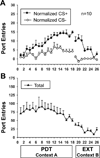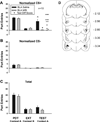Unilateral inactivation of the basolateral amygdala attenuates context-induced renewal of Pavlovian-conditioned alcohol-seeking
- PMID: 23758059
- PMCID: PMC4079556
- DOI: 10.1111/ejn.12278
Unilateral inactivation of the basolateral amygdala attenuates context-induced renewal of Pavlovian-conditioned alcohol-seeking
Abstract
Environmental contexts associated with drug use promote craving in humans and drug-seeking in animals. We hypothesized that the basolateral amygdala (BLA) itself as well as serial connectivity between the BLA and nucleus accumbens core (NAC core) were required for context-induced renewal of Pavlovian-conditioned alcohol-seeking. Male Long-Evans rats were trained to discriminate between two conditioned stimuli (CS): a CS+ that was paired with ethanol (EtOH, 20%, v/v) delivery into a fluid port (0.2 mL/CS+, 3.2 mL per session) and a CS- that was not. Entries into the port during each CS were measured. Next, rats received extinction in a different context where both cues were presented without EtOH. At test, responding to the CS+ and CS- without EtOH was evaluated in the prior training context. Control subjects showed a selective increase in CS+ responding relative to extinction, indicative of renewal. This effect was blocked by pre-test, bilateral inactivation of the BLA using a solution of GABA receptor agonists (0.1 mm muscimol and 1.0 mm baclofen; M/B; 0.3 μL per side). Renewal was also attenuated following unilateral injections of M/B into the BLA, combined with either M/B, the dopamine D1 receptor antagonist SCH 23390 (0.6 μg per side) or saline infusion in the contralateral NAC core. Hence, unilateral BLA inactivation was sufficient to disrupt renewal, highlighting a critical role for functional activity in the BLA in enabling the reinstatement of alcohol-seeking driven by an alcohol context.
Keywords: addiction; ethanol; nucleus accumbens; pavlovian conditioning; reinstatement; relapse.
© 2013 Federation of European Neuroscience Societies and John Wiley & Sons Ltd.
Figures





Similar articles
-
Pavlovian-conditioned alcohol-seeking behavior in rats is invigorated by the interaction between discrete and contextual alcohol cues: implications for relapse.Brain Behav. 2014 Mar;4(2):278-89. doi: 10.1002/brb3.216. Epub 2014 Feb 6. Brain Behav. 2014. PMID: 24683519 Free PMC article.
-
Blocking dopamine d1-like receptors attenuates context-induced renewal of pavlovian-conditioned alcohol-seeking in rats.Alcohol Clin Exp Res. 2014 Feb;38(2):418-27. doi: 10.1111/acer.12262. Epub 2013 Oct 24. Alcohol Clin Exp Res. 2014. PMID: 24164210 Free PMC article.
-
Alcohol-Seeking Triggered by Discrete Pavlovian Cues is Invigorated by Alcohol Contexts and Mediated by Glutamate Signaling in the Basolateral Amygdala.Neuropsychopharmacology. 2015 Nov;40(12):2801-12. doi: 10.1038/npp.2015.130. Epub 2015 May 8. Neuropsychopharmacology. 2015. PMID: 25953360 Free PMC article.
-
Vendor differences in alcohol consumption and the contribution of dopamine receptors to Pavlovian-conditioned alcohol-seeking in Long-Evans rats.Psychopharmacology (Berl). 2014 Feb;231(4):753-64. doi: 10.1007/s00213-013-3292-5. Epub 2013 Oct 6. Psychopharmacology (Berl). 2014. PMID: 24096535 Free PMC article.
-
Emotion and motivation: the role of the amygdala, ventral striatum, and prefrontal cortex.Neurosci Biobehav Rev. 2002 May;26(3):321-52. doi: 10.1016/s0149-7634(02)00007-6. Neurosci Biobehav Rev. 2002. PMID: 12034134 Review.
Cited by
-
Oral Conditioned Cues Can Enhance or Inhibit Ethanol (EtOH)-Seeking and EtOH-Relapse Drinking by Alcohol-Preferring (P) Rats.Alcohol Clin Exp Res. 2016 Apr;40(4):906-15. doi: 10.1111/acer.13027. Alcohol Clin Exp Res. 2016. PMID: 27038599 Free PMC article.
-
Varenicline Reduces Context-Induced Relapse to Alcohol-Seeking through Actions in the Nucleus Accumbens.Neuropsychopharmacology. 2017 Apr;42(5):1037-1048. doi: 10.1038/npp.2016.254. Epub 2016 Nov 11. Neuropsychopharmacology. 2017. PMID: 27834390 Free PMC article.
-
Genome-wide transcriptomics of the amygdala reveals similar oligodendrocyte-related responses to acute and chronic alcohol drinking in female mice.Transl Psychiatry. 2022 Nov 12;12(1):476. doi: 10.1038/s41398-022-02231-2. Transl Psychiatry. 2022. PMID: 36371333 Free PMC article.
-
Learning processes in relapse to alcohol use: lessons from animal models.Psychopharmacology (Berl). 2023 Mar;240(3):393-416. doi: 10.1007/s00213-022-06254-x. Epub 2022 Oct 20. Psychopharmacology (Berl). 2023. PMID: 36264342 Review.
-
Pavlovian-conditioned alcohol-seeking behavior in rats is invigorated by the interaction between discrete and contextual alcohol cues: implications for relapse.Brain Behav. 2014 Mar;4(2):278-89. doi: 10.1002/brb3.216. Epub 2014 Feb 6. Brain Behav. 2014. PMID: 24683519 Free PMC article.
References
-
- Arikan R, Blake NM, Erinjeri JP, Woolsey TA, Giraud L, Highstein SM. A method to measure the effective spread of focally injected muscimol into the central nervous system with electrophysiology and light microscopy. J Neurosci Methods. 2002;118:51–57. - PubMed
-
- Bouton ME. Context and behavioral processes in extinction. Learn Mem. 2004;11:485–494. - PubMed
-
- Brog JS, Salyapongse A, Deutch AY, Zahm DS. The patterns of afferent innervation of the core and shell in the “accumbens” part of the rat ventral striatum: immunohistochemical detection of retrogradely transported fluoro-gold. J Comp Neurol. 1993;338:255–278. - PubMed
Publication types
MeSH terms
Grants and funding
LinkOut - more resources
Full Text Sources
Other Literature Sources
Medical
Miscellaneous

